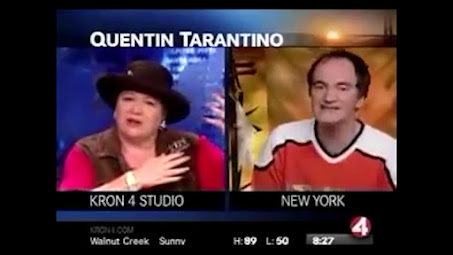The Sunny Gothicism of The Lost Boys
1. Sunshine Gothic
Smallpox and genocide. Rice hats and rail road ties. Flashbulbs and bathtub gin. Paranoia and internment camps. LSD and free love. Welcome to sunny California--the place where the scarlet wave of Manifest Destiny finally broke and rolled back, leaving those unlucky enough to get caught up in the undertow gasping for breath on the surf; the place where a hard bitten, bootlegging Irishman bankrolled cheap flicks and laid the foundation for Camelot; the place where Sunshine Gothic was born.
Coined by Twitter user @blauer_geist, the term "Sunshine Gothic" refers to a loose connection of media artifacts united by their collective preoccupation with the American west coast generally and California specifically. In many respects, Sunshine Gothic can be understood as a reaction to the 1969 Tate-LaBianca murders. @blauer_geist writes, "The Manson rituals, committed 50 years ago during the dog days of 1969, occurred at the intersection of 'Devil's work' and deep politics, the zenith of #SunshineGothic." He continues, stating that "Everything Hollywood has done since has been an attempt to grapple with the bloodshed at 10050 Cielo Drive." A bold claim, to be sure, but one that is nonetheless difficult to refute.
The most recent, and perhaps most obvious, entry in the Sunshine Gothic canon is Quentin Tarantino's 2019 film Once Upon a Time in Hollywood, which deals directly with the Manson murders and their impact on the collective imagination. And though OUATIH stands as a very clear articulation of what Sunshine Gothic is, there is another film that deploys the motifs that define the genre with far more subtlety: Joel Schumacher's 1987 vampire classic The Lost Boys.
2. The Lost Boys
The Lost Boys follows teenage brothers Michael (Jason Patric) and Sam (Corey Haim) as they attempt to settle into their new home in Santa Clara, California following the dissolution of their parents' marriage. Unbeknownst to the brothers, Santa Clara boasts a thriving population of vampires, who soon set their sights on the pair after a chance encounter on the boardwalk. Things quickly spiral out of control as Michael is seduced by a vampiric temptress and turned, while Sam falls in with the Frog brothers (Corey Feldman and Jamison Newlander)--two comic book pushers with aspirations of Van Helsing-dom.
Though the film is widely regarded as a goth staple, The Lost Boys has a surprisingly, and decidedly, conservative streak. The vampires are more or less an embodiment of Reagan era neuroses: they can just as plausibly be read as a metaphor for Soviet subversion, homosexuality, or drug addiction. But the horror of The Lost Boys is much older than black eye-liner and big hair; it stretches back to the heady days of the 1960s, to the hippy love children and biker gangs of Hunter S. Thompson's America. And it is precisely the use of these motifs that merit The Lost Boys' inclusion as part of the Sunshine Gothic.
3. "But they dress better"
Santa Clara seems to have been put into suspended animation circa 1965. Or, at least the adults seem to have been. Michael and Sam's grandfather (Barnard Hughes) is a Willie Nelson-esque stoner. Even their mother (Dianne Wiest), who has presumably been away from the town for nearly twenty years, almost immediately slips back into the lifestyle, dismissing the excesses of David's (Kiefer Sutherland) clan by saying, "Oh, they're just young. We were that age, too, once. But they dress better." The reveal that David and his friends are, in fact, vampires, is the confirmation of every adult's worst fear: the kids are not alright.
4. "Like the mystics and statistics say it will..."
Nowhere do the counter cultural affinities of the vampiric brood become more apparent than in their cavernous seaside lair. As David explains, the grotto the vampires call home contains the sunken ruins of a hotel that fell into the ocean during the 1906 earthquake that, quite literally, shook San Francisco to its core. In the intervening decades, the creatures furnished their abode with various knick-knacks and treasures; surfboards, crushed velvet armchairs, and, most notably, a larger-than-life portrait of the Lizard King himself.
And who better personifies the chaotic spirit of hippy culture than Jim Morrison? The vampires of The Lost Boys are atavisms, a terrifying return to the untamed pain and pleasures of the 1960s. In short, they are Morrison reborn in black leather. Indeed, the Echo and the Bunnymen cover of "People Are Strange" that has become practically synonymous with The Lost Boys perfectly encapsulates the themes and attitude of the film. Despite its New Wave flourishes, the lyrics remain the same; there is nothing new under the sun. Or the moon, for that matter.



Comments
Post a Comment